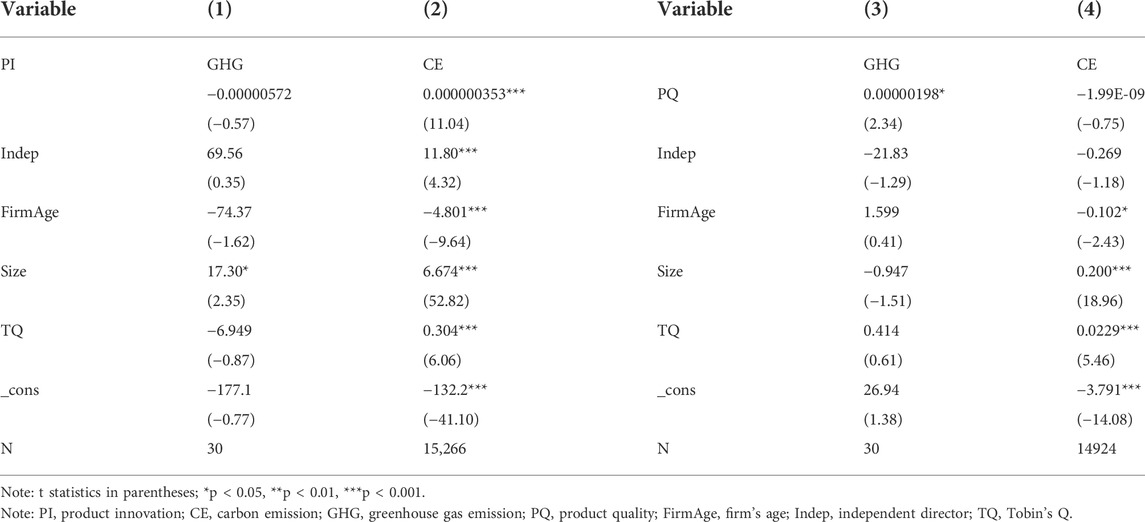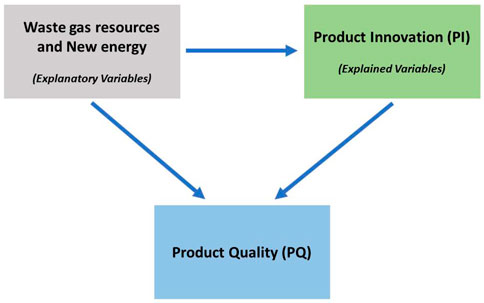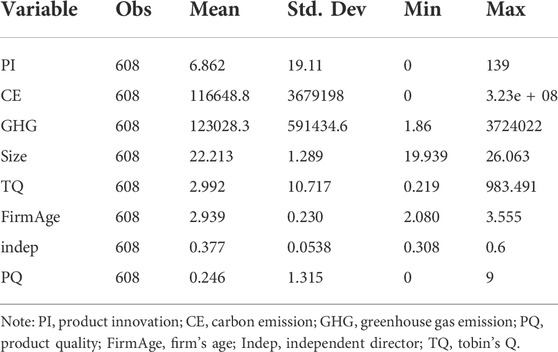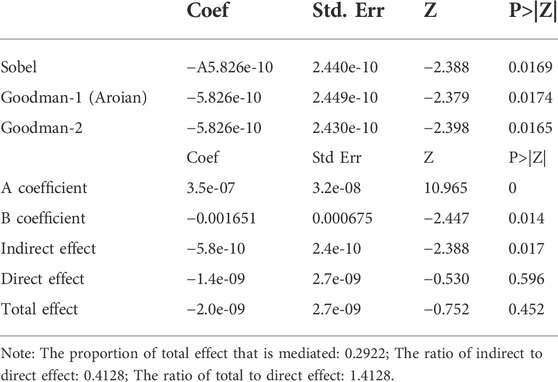- 1School of Business and Economics, Universiti Putra Malaysia, Seri Kembangan, Malaysia
- 2Faculty of Management, Multimedia University Malaysia, Cyberjaya, Malaysia
- 3Department of Business Administration, Daffodil International University, Dhaka, Bangladesh
- 4School of Economics and Management, East China Jiaotong University, Jiangxi, China
These days energy-related enterprises started using a fancy terminology called circular economy (CE) to display their progress in opting for innovative approaches to mitigate carbon emissions and waste gas released in the enterprise during the operation. Hence, this paper examines whether there is any mediating role of innovation from a CE point of view or not in managing the waste resources and minimising the carbon emission on the innovation and quality of new energy products. For this, secondary data with a sample observation of 608 was selected from Chinese listed enterprises from 2015–2020. The empirical results revealed that the waste resource utilisation by firms is helpful to the quality of their products but does not significantly affect the innovation of their new energy products. In addition, the evidence from developing countries shows that companies’ carbon reduction behaviour benefits their new energy product innovation. However, it does not significantly impact the quality of their products. Model validation analyses the existence of corporate waste resource utilisation through corporate new energy product innovation, thereby contributing to corporate product quality. Overall, this paper facilitates enterprises’ new energy product development activities and fills the research gap between companies’ waste gas resource utilisation and new energy product innovation.
1 Introduction
With the increase in human and economic activity, the global climate is getting deteriorated, resulting in land and sea warming, rising sea levels, degradation of glaciers, frequent extreme weather events and other acute events that cause disasters. Even the economic downturn associated with the COVID-19 outbreak has failed to contain the drivers of climate change (The Global Climate Status Report, 2020). As a result, the year 2020 remained as one of the three hottest years on record, with a global average temperature of around 1.2°C higher than temperatures observed in the pre-industrial era (1850–1900). Not only the rise in temperatures but climate change-related disasters are frequently happening in developed and developing countries. Such disasters have become the main concern for governments in developed and developing countries (Del Giudice et al., 2021). So, understanding the environmental impacts due to various initiatives have become mandatory, and at the same time, economic stability should be achieved (Bag et al., 2022).
The circular economy is a concept that has become popular in the last decade and can potentially promote economic stability and sustainable development. However, it has to be implemented only through corporate strategies; only then the true potential can be realised. Considering the energy sector, the circular economy is being promoted widely, especially in the content of waste to energy. More recently, new energy sources such as solar photovoltaics, wind energy, biomass, fuel cells and others have also gained importance in the circular economy context. At the same, new processes and technologies and integrated approaches have also evolved, focusing on net zero or near zero emissions. Such developments attracted energy and other energy-dependent sectors, for instance, iron and steel, paper, and cement. As a result, the captive power plants in the industries started expanding from an innovation point of view.
So, promoting new energy sources is one of the essential options for decarbonising and increasing fuel diversity. Furthermore, with the development of energy saving and emission reduction technologies, the advantages of new energy sources, such as low consumption and low exhaust emissions, are gaining increasing attention. Meeting environmental issues and resource efficiency requirements in manufacturing has become necessary to achieve effective production management. The circular economy aims to reduce resource consumption by slowing, closing and shrinking resource cycles (Geissdoerfer et al., 2017). Through the use of new energy sources and recycled materials, a circular economy can help reduce lifecycle greenhouse gas emissions and resource consumption (Aguilar Esteva et al., 2021). Thus, while the circular economy is inextricably linked to carbon reduction in enterprises, it also promotes product innovation for environmental protection.
The circular economy is a series of abstract concepts (Ripanti & Tjahjono, 2019), and past research has found that the circular economy can provide innovation in environmentally friendly products (Hopkinson et al., 2018) or processes that transform environmentally friendly resources into a variety of usable products and services and ultimately manifest in products or consumers (Lloret 2016). As the evolution of CE shows its multidisciplinary background, Pizzi et al., 2020 argue that approaches from various disciplines such as engineering, economics and ecology have contributed to its development. As a theoretical basis, the circular economy provides a favourable research perspective. There are many perspectives on new energy sources at this stage of research and study, often focusing on new energy products and corporate financing models and the impact of crude oil prices on new energy product innovation (He et al., 2022; Fu & Yang’s 2021). Some scholars have focused on recycling within the production cycle of products and the recycling of industrial solid waste (Richa et al., 2017; Martínez-Martínez et al., 2020). However, there is less research on the study of carbon reduction and corporate waste gas resource use in new energy product innovation. So, this study seeks to explore the impact of corporate carbon reduction behaviour and waste body resource use on corporate new energy product innovation and quality. So, we formulated the following research questions; 1). Does carbon emission reduction by enterprises improve new energy product innovation and product quality?; 2). Does waste gas emission utilisation promote environmental innovation by enterprises; and 3). Does waste gas resource utilisation improve product quality through green innovation?
Hence, to answer the above-raised research questions, this study aims to explore whether the enterprises’ carbon and greenhouse gas emission reduction promotion is conducive to their product innovation and quality improvement. This study also attempts to analyse the mediating effect of new energy product innovation between product quality as well as waste gas emission utilisation. The past literature has suggested a higher expected return on investment for new energy products and technology innovation (He et al., 2022). This study also considers the relationship between innovation and quality of new energy products and whether there are potential channels for more linkages between new energy product innovation and the quality of products using waste gas resources. The impact of the endogeneity problem of the variables on the regression results is quite often raised in the literature, which is also addressed in this study by proposing a firm fixed effects model.
The manuscript is structured in three sections. Section 2 presents the framework and data sources. Section 3 presents the sample selection and models used for the analysis. In Section 4, the observed results are presented with a brief discussion, followed by conclusions and future work in Section 4.
2 Framework and data collection
Based on the objective, we have formulated the research framework shown in Figure 1. The framework consists of two main variables: Explanatory and explained. The explanatory variables are the waste gas resources, exhausts and any other energy type in the firm (that includes renewables too). The explained variables are the product innovation approaches used in the firm. In the below subsections, these two variables are clearly explained along with control variables, which collectively would affect the product quality in the firm.
2.1 Explanatory variables
According to Fu & Yang’s (2021) research on product measures for a new energy firm, most enterprises reuse waste gas resources for industrial production. So, a firm’s waste gas resource utilisation and carbon emission reductions can be the core explanatory variables. These can be measured or collected from the greenhouse gas emissions and the firm’s carbon emission reduction reports. Cheng et al. (2021) also state that greenhouse gas emission reduction of enterprises can be a good standard to measure waste gas resource utilisation. The data source for greenhouse gas and carbon emission reduction is the China Industrial Enterprises Database (2015–2020).
2.2 Explained variables
The explained variable is considered to be the firm’s new energy product innovation, which is measured by the firm’s product-related new energy patents (Bag et al., 2022; He et al., 2022). The firm’s product innovation data is obtained from the China Research Data Service (CNRDS). In addition, information on product quality is extracted from Corporate Social Responsibility (CSR) and financial data, and the Production Quality (PQ) variable is measured by the product quality score disclosed in the CSR.
2.3 Control variables
Control variables are chosen to assess the impact of carbon emission reduction and exhaust gas resources on new energy products’ innovation and product quality and exclude other confounding factors. The control variables, the firm’s age, size and Tobin’s Q are represented by Indep, FirmAge, Size, and TQ, respectively. These variables are obtained from the firms’ annual financial reports, and the firm’s financial information is obtained from the China Stock Market Accounting Research Database (CSMAR).
3 Sample selection and methodology
3.1 Sample selection
The selected sample for this study is the panel data of listed enterprises in mainland China. An adequate sample size of 608 enterprises listed between 2015–2020 was obtained. For all these 608 enterprises or firms, the data related to three variables (explanatory, explained, and control) is collected using the resources mentioned in Section 2.
3.2 Model setting
For every enterprise or firm, our focus is mainly on understanding the impact of carbon emission reduction and exhaust pollutants on the innovation of new energy products from a circular economy perspective. For this, we developed the fixed effects models briefly presented below:
Model 1: Aims to explore the impact of corporate carbon emission reduction on new energy product innovation, as given in Eq. 1.
where
Model 2: Aims to explore whether greenhouse gas emission reduction promotes enterprise environmental protection innovation, as given in Eq. 2.
where
Model 3: investigate the influence of enterprise carbon emission reduction on product quality, as given in Eq. 3.
where
Model 4: analyses whether greenhouse gas emission reduction can improve product quality through green innovation, as given in Eq. 4.
where
4 Results and discussion
This section presents the data analysis results as well as the main empirical results and the discussion. The descriptive statistical analysis of the collected 608 enterprises’ sample data is shown in Table 1. The observed correlations between variables are listed in Table 2.
Table 3 reveals the regression results for Models 1–4. Model 1 reported the impact of corporate GHG emission reduction on corporate new energy product innovation. The results reflect that the use of waste gas resources does not have a direct positive impact on the innovation of new energy products, with a correlation coefficient of −0,57. However, for the reduction of carbon emissions (Model 2), the adoption of carbon reduction behaviour by companies has a significant positive relationship with the innovation of new energy products, with a p-value = 0 (<0.05) and a positive correlation. Furthermore, Model 3 reveals that the use of waste resources significantly affects the quality of a company’s products, with a p = 0.028 (<0.05) and a positive correlation coefficient. The results of model 4 show that carbon reduction behaviour does not effectively stimulate product quality and has a negative correlation.

TABLE 3. Regression results of enterprise carbon emission and greenhouse gas emission reduction on products.
The use of exhaust gas resources in enterprises’ new energy innovations is insignificant because new energy product innovations generally use new energy power such as photovoltaics, wind, fuel cells and others. While the use of exhaust gas resources is generally reflected in the innovation process but the technology and systems are mainly considered old or relatively conventional. Therefore, from a technical point of view, there is limited scope to improve the number of patents granted for the use of waste gas resources. In addition, the reason why carbon reduction does not directly improve the quality of a company’s products in this study is considered to be that carbon emission reduction behaviour in the production process is not related to the product quality of enterprises. So it will not have a direct impact. However, coming to the economic benefits, the past study by Xue et al. (2019) showed that carbon reductions in the circular model could generate additional revenue. Therefore, carbon reductions from this mode can have significant environmental and economic benefits. Shan et al. (2021) found that green innovation and renewable energy reduce carbon emissions when put under this approach in a given enterprise or firm, depending upon the industrial operations they perform. Thus, the model proposed in this study is further analysed to understand the relationship between corporate waste resource utilisation and corporate new energy product innovation, thereby contributing to corporate product quality. For this, a Sobel test is performed, and the results can be seen in Table 4.
Although in the previous model, corporate waste resource utilisation did not have a positive impact on new energy product innovation, the results of the Sobel test show that there is a partial mediating pathway existing for corporate waste resource utilisation through new energy innovations and thus have an impact on the quality of the firm’s products. The mediating effect accounted for 29.22% of the total effect, and the ratio of indirect to direct effect was 41.28%.
5 Conclusion and future work
The circular economy is a concept promoted by policymakers and businesses worldwide (Iaquaniello et al., 2018), emphasising waste as a way to close the cycle and minimise resource use (Hollins et al., 2017). Therefore in a circular economy, in addition to using and reducing waste, there needs to be an incentive to make products that do not become waste, which is product innovation (Iaquaniello et al., 2018). The empirical results of this paper show a model of the impact of carbon emission reduction and waste resource utilisation on the innovation and quality of new energy products for Chinese listed enterprises with a total sample observation of 608. It also analyses the impact of carbon emission reduction and waste resource utilisation of enterprises on new energy product innovation and quality based on a circular economy perspective, as well as the mediating role of new energy innovation. The model results of this paper show that the use of waste gas resources by companies is an important factor in improving the quality of their products. However, it does not positively affect the innovation of new energy products. In addition, the model results reveal that companies’ carbon reduction behaviour is beneficial to their new energy product innovation but has a negative impact on their product quality that warrants our attention. The results of this paper are beneficial to the company’s internal governance, such as the R&D and innovation activities of new energy products and the control of product quality. At the same time, the findings of this study will fill the research gap between companies’ waste gas resource utilisation and new energy product innovation. However, this paper only focuses on Chinese companies from 2015 to 2020. Future research could consider other long-term results or markets in other countries or regions.
Data availability statement
The original contributions presented in the study are included in the article/Supplementary Material, further inquiries can be directed to the corresponding authors.
Author contributions
All authors listed have made a substantial, direct, and intellectual contribution to the work and approved it for publication.
Funding
The authors extend their gratitude to Universiti Putra Malaysia for this research opportunity. This work was supported by Grant number FRGS/1/2020/SS01/MMU/02/4.
Conflict of interest
The authors declare that the research was conducted in the absence of any commercial or financial relationships that could be construed as a potential conflict of interest.
Publisher’s note
All claims expressed in this article are solely those of the authors and do not necessarily represent those of their affiliated organizations, or those of the publisher, the editors and the reviewers. Any product that may be evaluated in this article, or claim that may be made by its manufacturer, is not guaranteed or endorsed by the publisher.
References
Aguilar Esteva, L. C., Kasliwal, A., Kinzler, M. S., Kim, H. C., and Keoleian, G. A. (2021). Circular economy framework for automobiles: Closing energy and material loops. J. Ind. Ecol. 25 (4), 877–889. doi:10.1111/jiec.13088
Bag, S., Dhamija, P., Bryde, D. J., and Singh, R. K. (2022). Effect of eco-innovation on green supply chain management, circular. economy capability, and performance of small and medium enterprises. J. Bus. Res., 141, 60–72. doi:10.1016/j.jbusres.2021.12.011
Cheng, L., Liu, Y., Lou, X., Chen, Z., and Yang, Y. (2021). Does technology conglomeration promote innovative outcomes of new energy vehicle enterprises? The moderating effect of divisive faultlines. J. Clean. Prod., 324, 129232. doi:10.1016/j.jclepro.2021.129232
Del Giudice, M., Chierici, R., Mazzucchelli, A., and Fiano, F. (2021). Supply chain management in the era of circular economy: The moderating effect of big data. Int. J. Logist. Manag. 32 (2), 337–356. doi:10.1108/IJLM-03-2020-0119
Fu, Q., and Yang, Z. (2021). Mode selection and risk estimation of financing in new energy automobile enterprises. Energy Rep., 7, 330–337. doi:10.1016/j.egyr.2021.06.053
Geissdoerfer, M., Savaget, P., Bocken, N. M. P., and Hultink, E. J. (2017). The Circular Economy – a new sustainability paradigm? J. Clean. Prod. 143, 757–768. doi:10.1016/j.jclepro.2016.12.048
The Global Climate Status Report (2020). NOAA national centers for environmental information, state of the climate: Monthly global climate report for annual 2020. Available at: https://www.ncei.noaa.gov/access/monitoring/monthly-report/global/202013.
He, J., Li, J., Zhao, D., and Chen, X. (2022). Does oil price affect corporate innovation? Evidence from new energy vehicle enterprises in China. Renew. Sustain. Energy Rev., 156, 111964. doi:10.1016/j.rser.2021.111964
Hollins, O., Lee, P., Sims, E., Bertham, O., Symington, H., Bell, N., et al. (2017). Towards a circular economy–Waste management in the EU. STOA–EU. 978-92-846-1548-3. Available at: https://www.europarl.europa.eu/at-your-service/en/stay-informed/research-and-analysis.
Hopkinson, P., Zils, M., Hawkins, P., and Roper, S. (2018). Managing a complex global circular economy business model: Opportunities and challenges. Calif. Manag. Rev. 60 (3), 71–94. doi:10.1177/0008125618764692
Iaquaniello, G., Centi, G., Salladini, A., Palo, E., and Perathoner, S. (2018). Waste to chemicals for a circular economy. Chem. Eur. J. 24, 11831–11839. doi:10.1002/chem.201802903
Lloret, A. (2016). Modeling corporate sustainability strategy. J. Bus. Res. 69 (2), 418–425. doi:10.1016/j.jbusres.2015.06.047
Martínez-Martínez, S., Pérez-Villarejo, L., Eliche-Quesada, D., Sánchez-Soto, P. J., Christogerou, A., Kanellopoulou, D. G., et al. (2020). New waste-based clinkers for the preparation of low-energy cements. A step forward toward circular economy. Int. J. Appl. Ceram. Technol. 17 (1), 12–21. doi:10.1111/ijac.13390
Pizzi, S., Caputo, A., Corvino, A., and Venturelli, A. (2020). Management research and the UN sustainable development goals (SDGs): A bibliometric investigation and systematic review. J. Clean. Prod. 276, 124033. doi:10.1016/j.jclepro.2020.124033
Richa, K., Babbitt, C. W., and Gaustad, G. (2017). Eco-efficiency analysis of a lithium‐ion battery waste hierarchy inspired by circular economy. J. Industrial Ecol. 21 (3), 715–730. doi:10.1111/jiec.12607
Ripanti, E. F., and Tjahjono, B. (2019). Unveiling the potentials of circular economy values in logistics and supply chain. management. Int. J. Logist. Manag. 30 (3), 723–742. doi:10.1108/IJLM-04-2018-0109
Shan, S., Genç, S. Y., Kamran, H. W., and Dinca, G. (2021). Role of green technology innovation and renewable energy in. Carbon neutrality: A sustainable investigation from Turkey. J. Environ. Manag. 294, 113004. doi:10.1016/j.jenvman.2021.113004
Keywords: carbon emission 1, waste gas resources2, new energy3, reduction4, circular economy5
Citation: Ao X, Teh BH, Ong TS, Muhammad H, Selamat AI and Chen A (2022) Does the utilisation of new energy and waste gas resources contribute to product innovation from the perspective of a circular economy? Evidence from China. Front. Energy Res. 10:918425. doi: 10.3389/fenrg.2022.918425
Received: 12 April 2022; Accepted: 03 August 2022;
Published: 05 September 2022.
Edited by:
Nallapaneni Manoj Kumar, City University of Hong Kong, Hong Kong SAR, ChinaReviewed by:
Alberto-Jesus Perea-Moreno, University of Cordoba, SpainMohieddine Rahmouni, King Faisal University, Saudi Arabia
Copyright © 2022 Ao, Teh, Ong, Muhammad, Selamat and Chen. This is an open-access article distributed under the terms of the Creative Commons Attribution License (CC BY). The use, distribution or reproduction in other forums is permitted, provided the original author(s) and the copyright owner(s) are credited and that the original publication in this journal is cited, in accordance with accepted academic practice. No use, distribution or reproduction is permitted which does not comply with these terms.
*Correspondence: Tze San Ong, dHplc2FuMDMzQGhvdG1haWwuY29t; Boon Heng Teh, Ymh0ZWhAbW11LmVkdS5teQ==
†ORCID: Tze San Ong, https://orcid.org/0000-0001-7756-9404
 Xiangyuan Ao1
Xiangyuan Ao1 Tze San Ong
Tze San Ong


